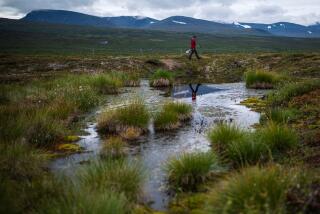A Rent-an-Ocean for Research : Greenhouse Effect Is Subject of Tests at Irvine Wave Pool
- Share via
IRVINE — The problem is huge: an alarming increase worldwide in carbon dioxide.
But a perfect test tube for scientists studying the problem turned out to be relatively compact: an amusement-park swimming pool.
For two weeks, a team of scientists from Battelle Marine Sciences Laboratory in Sequim, Wash., used the big-wave swim pool at Wild Rivers Waterpark here. The pool, with its realistic waves, became an ocean in miniature.
“We searched all over, and we found this pool is just what we needed for our tests,” said John P. Dowling, an oceanographer with Battelle.
Dowling, who worked with four other Battelle scientists, said the results of their study which ended Thursday may help the world better respond to the so-called “greenhouse effect,” a worrisome jump in carbon dioxide in the atmosphere that is suspected of causing global warming.
Because oceans absorb about 40% of Earth’s carbon dioxide, a better understanding of their relationship with the atmosphere may help explain global warming.
“It’s a very interesting fact,” Dowling said. “The ocean is the largest natural sink that we know of. If the ocean were to take up more or less of CO2(carbon dioxide) for some reason, (the world) would have either more of a problem or less of a problem than we have now with the greenhouse effect.”
Battelle’s study of the ocean-atmosphere phenomenon is funded by a $600,000 grant from the U.S. Department of Energy.
“What we’re trying to do for the Department of Energy is to develop a way to detect, by use of a satellite, the gas exchange between the atmosphere and the ocean,” Dowling said. He said the Battelle study hopes to find a way of relating ocean wave action to gas absorption. An orbiting satellite, scanning the oceans, could detect oceanic activity and, by use of a scale, predict the amount of carbon dioxide and other gases absorbed or released by the ocean, Dowling said.
Wave action needs particular study, Dowling said, because big waves enhance the ocean’s ability to absorb gases, including carbon dioxide.
The pool at Wild Rivers proved to be just what marine scientists needed, Dowling said. Standing by the pool recently, he pointed to waves and said, “Look at that foam. Those are real waves. These are just what we needed to study. If we we had to do this in the real ocean, the experiment would cost 10 times as high.”
Battelle paid Wild Rivers $18,000 to use its big pool as a laboratory for two weeks last month, when the rides are closed for the season.
The study produced some interesting sights:
* A long steel boom extended over the pool. A video camera and radiometer--an instrument to measure microwaves emitted by surf action--dangled from the steel boom.
* Scientists in wet suits waded into the churning pool, took water samples in syringes, and then tested the water for tiny amounts of inert gases they had injected into the pool water.
* Computers and video screens at the side of the pool reflected the array of action recorded by the camera and radiometer hanging over the pool.
The scientists also studied foam and bubbles to see how much gas exchange goes on between air and ocean when wave activity creates certain levels of bubble action.
“Bubbles are very efficient emitters of microwaves,” said Bill Asher, one of the Battelle scientists. “We measure the amount of microwaves emitted by the water bubbles.”
The United States already has two satellites in orbit with equipment that could measure microwave activity of ocean waves. That data, in turn, could then be converted into information about rates of carbon dioxide absorption by the oceans, Asher said.
“If there are changes in the (world’s) climate because of the greenhouse effect, there may be changes where the storms and waves are,” Dowling said. “The hurricanes might be in different places. The (weather) system may be out of whack.”
Within the next two years, he added, the Battelle scientists will be studying real ocean waves, probably those off the coast of Massachusetts.
The Wild Rivers study “has been a small part of the (investigative) chain, but an important part,” Asher said.
The study may also be a scientific first of another sort, he said with a smile.
“As far as we can tell, this is the first time a serious scientific experiment has been carried on at an amusement park.”
The Sea as Cleanser Research recently conducted in Orange County may lead to a system enabling scientists to determine the amount of carbon dioxide absorbed by the world’s oceans. How that system would work: 1. Carbon dioxide: A colorless, ordorless gas, it is produced by the burning of anything containing carbon. Major sources include factories and automobiles. More carbon dioxide could possibly lead to an increase in the Earth’s atmospheric temperature. 2. Absorption: Oceans absorb about 40% of the world’s carbon dioxide. 3. Turbulence: Ocean action increases absorption. Waves produce bubbles that emit microwaves. 4. Wave size: Larger waves cause higher absorption rates than smaller ones, and therefore greater microwave emissions. 5. Observation: Satellites can detect the differences in microwave emission and therefore track absorption rates. This data is transmitted to scientists for analysis. Source: Battelle Marine Sciences Laboratory. Researched by BILL BILLITER / Los Angeles Times






